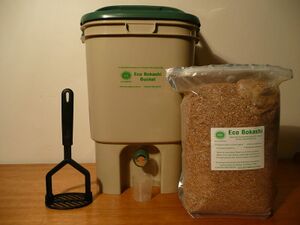
Effective Microorganisms aka EM, or efficient microbes, are a cluster of beneficial organisms - developed by Dr. Teruo Higa, a horticultural professor at U of Ryukus, Japan - which ferment organic matter in an anti-oxidative way.
The essential basic technology of EM is a consortium of five or more species of microorganisms, from across at least three classes of organisms, in a synergistic culture (called a consortium) which produces lactic acid under anaerobic fermentation and which also produces an environment (in the liquid or plant matter under fermentation, etc.) which is highly antioxidative and regenerative, or syntropic (aka anti-entropic) and which contains numerous powerful antioxidants, largely produced by phototrophic anaerobic bacteria known as purple non-sulfur bacteria (PNSB).
EM technology has now become a major science, assisting in the creation of sustainable practices for agriculture, human health and hygiene, animal husbandry, nature farming, environmental stewardship, disaster relief, construction, industrial, community activities and more.
EM has found useful applications in the following areas, and likely many more:
- agriculture: for conditioning soil, compost and plant wastes. Continued use of EM can convert a soil to a truly sustainable type of soil, called a zymogenic soil
• agriculture: for feeding livestock, for waste treatment, for odor control and pest management (e.g., flies);
• manages odors, improves feed utilization, improves health and vitality
• agriculture: for treating or controlling various fungal diseases or pests of plants
• lawn maintenance: for treating soil and compost or organic fertilizers, for preventing fusarium and molds
• buildings and architecture: to maintain healthy buildings and building materials (lumber, concrete, plaster, etc.), to prevent "sick building syndrome" and extend life of materials
• as a deodorizer for barns, waste treatment areas, homes, etc.
• as an aerosol spray deodorizer for home, agricultural and industrial use
• household: pets, odor control, treating pet wastes on floors, for shower stalls, kitchen sinks, dishpans, garbage pails, toilets, drains, sinks, sink drains, compost buckets, etc.
• human and animal use: ingestion of a wide range of antioxidative and regenerative products made from EM, as a healthful probiotic and antioxidant supplement
• waste treatment
• wastewater treatment
• septic waste treatment
• for remediation of polluted or unbalanced waterways, streams, bays, ponds and lakes
• toxic waste remediation
• preparation of waste biomass material for bio-conversion into fuels such as biodiesel and others
These beneficial phototrophic microorganisms are also used to make EM ceramics, bokashi, EM-X ceramics, EM salt, antiox brews, fermented antioxidant brews and many more products.
Scientific References[edit | edit source]
- Evaluation of Effective Microorganism (EM) for treatment of domestic sewage
- Teruo Higa's paper
- 2012 brief analysis of published journals by Linda Chalker-Scott which questions whether bokashi makes any difference compared to conventional composting as a soil amendment